
CANDID: Meet grad student Matthew Sawatzky
Matthew Sawatzky is one of the roughly 3,800 students enrolled in the University of Manitoba’s Faculty of Graduate Studies. Students like him come from around the world to study here and UM Today is getting to know some of them on a more personal, candid, level.
Sawatzky has a photo exhibit in the Daily Bread Café that features people and waterways that have been affected by hydro development in Northern Manitoba. “A Sad Sort of Clean: Hydropower in Northern Manitoba” runs until November 16 and combines Sawatzky’s love of photography and background in international development.
Masters student: Matthew Sawatzky
Studying: Landscape Architecture
How did you make the jump from international development to landscape architecture?
For my summer jobs I’ve been landscaping for some companies in the city. It was a great job for making money for tuition but I wanted to go a bit further, get into the design aspect of what we were working on. I looked up landscaping on the U of M page and landscape architecture came up and I found it was a great fit for what I was interested in.
What did you like about it?
There were a lot of things I was thinking about for a long time and didn’t realize there was an entire faculty department devoted to it. The way spaces are laid out, the way the city works and when I found out landscape architecture dealt with all of those things it was a no-brainer to apply. I like how designed space can influence our day in positive and negative ways. A well-designed space can make your day better or can make an environment more pleasing and more welcoming and safe. And because I’ve been building spaces for years, understanding how those spaces were set up was really interesting to me.
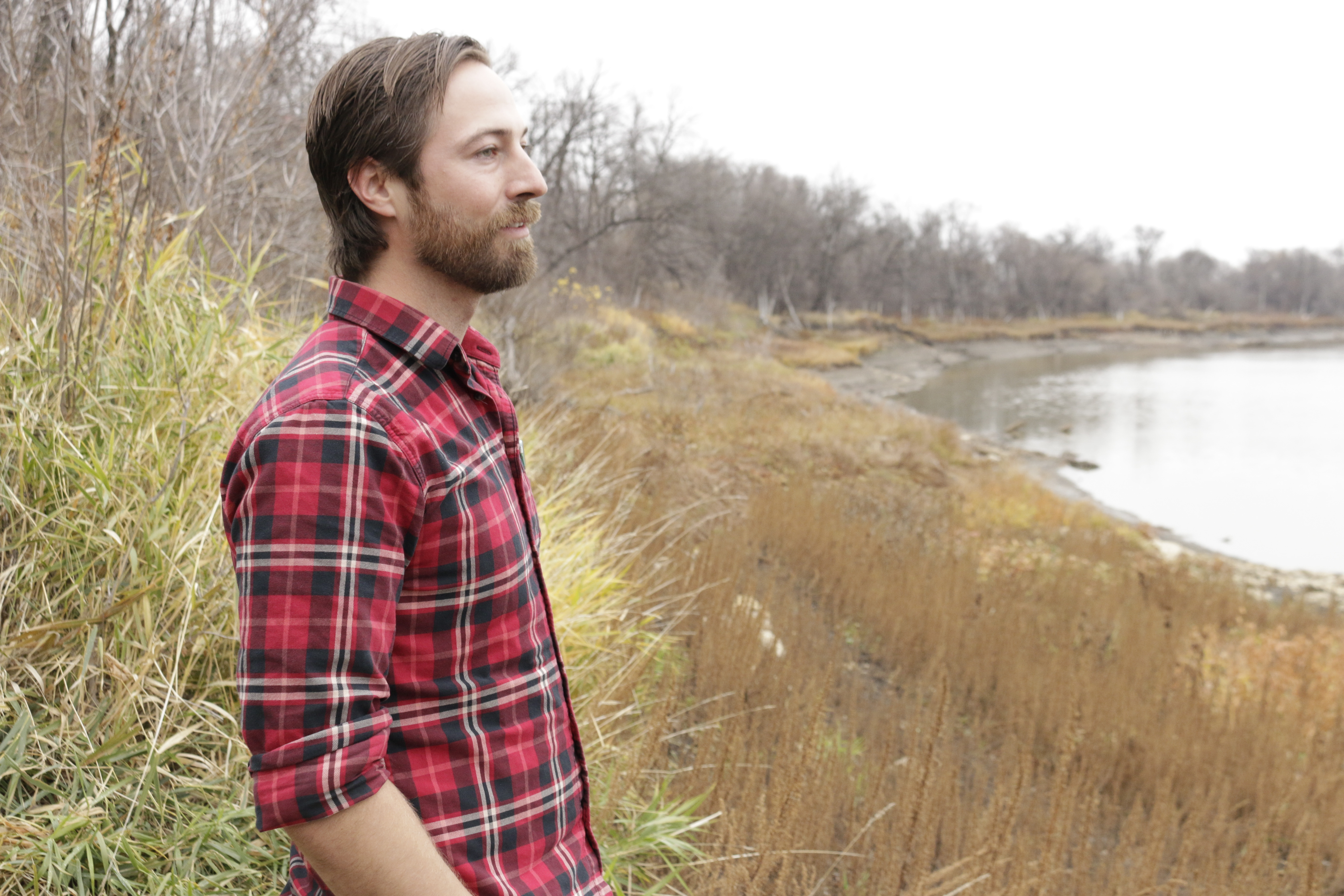
Do you think, given the way Winnipeg is structured now, are those changes possible?
I think some of them are possible. There’s a different climate, different mentality and we’re a lot more spread out so we can install small-scale improvements and it won’t all happen overnight but it will happen over time. Even small things like the Sherbrook streetscape is really interesting. They’ve widened sidewalks and they have that protected bike lane in place and I think that’s a step in the right direction for sure.
You’re into photography, how did that start?
It started when I just graduated high school. My parents bought me a small point and shoot camera and I did a trip to central America and I really enjoyed taking pictures and swapping them with my friends. After that I saved up and bought an SLR and that was my main hobby for years. It grew into more of a professional pursuit and I went to Prairieview School of Photography to learn more.
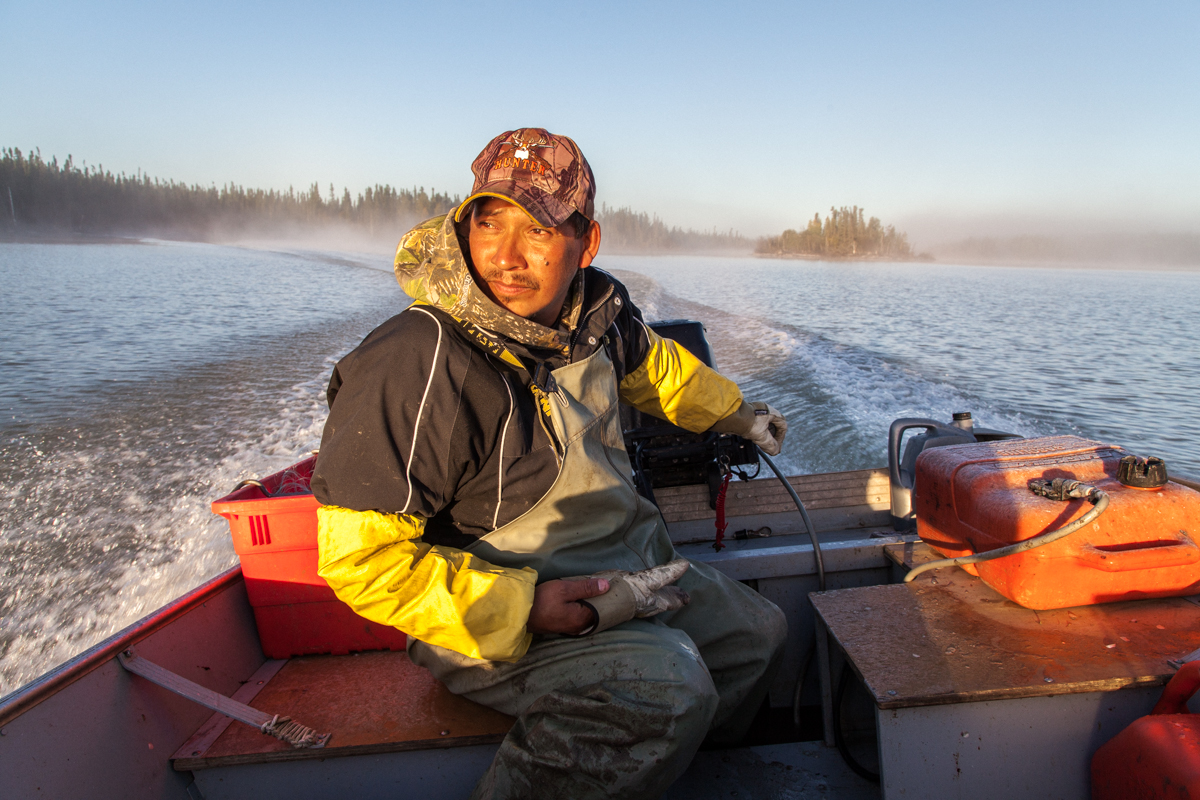
Hunter, trapper, fisher Robert Spence of Tataskweyask Cree Nation (Split Lake) // Photo by Matthew Sawatzky, A Sad Sort of Clean
You’re showing your exhibit, A Sad Sort of Clean, is this your first exhibit?
Yeah, this is my first major exhibit.
And your first travelling exhibit?
Yeah.
Did you have a theme going into the project or did it come about organically?
We had a pretty clear vision to begin with. It was to show the impact of hydro development up north and on the local people where lake levels have risen or fallen or been manipulated in some sort of way and how we think hydro power is a very clean source of energy and in a lot of ways it is, but in some ways there’s a human cost to the abundant energy the south of Manitoba enjoys so much. That was our goal – to show the other side of that power production.
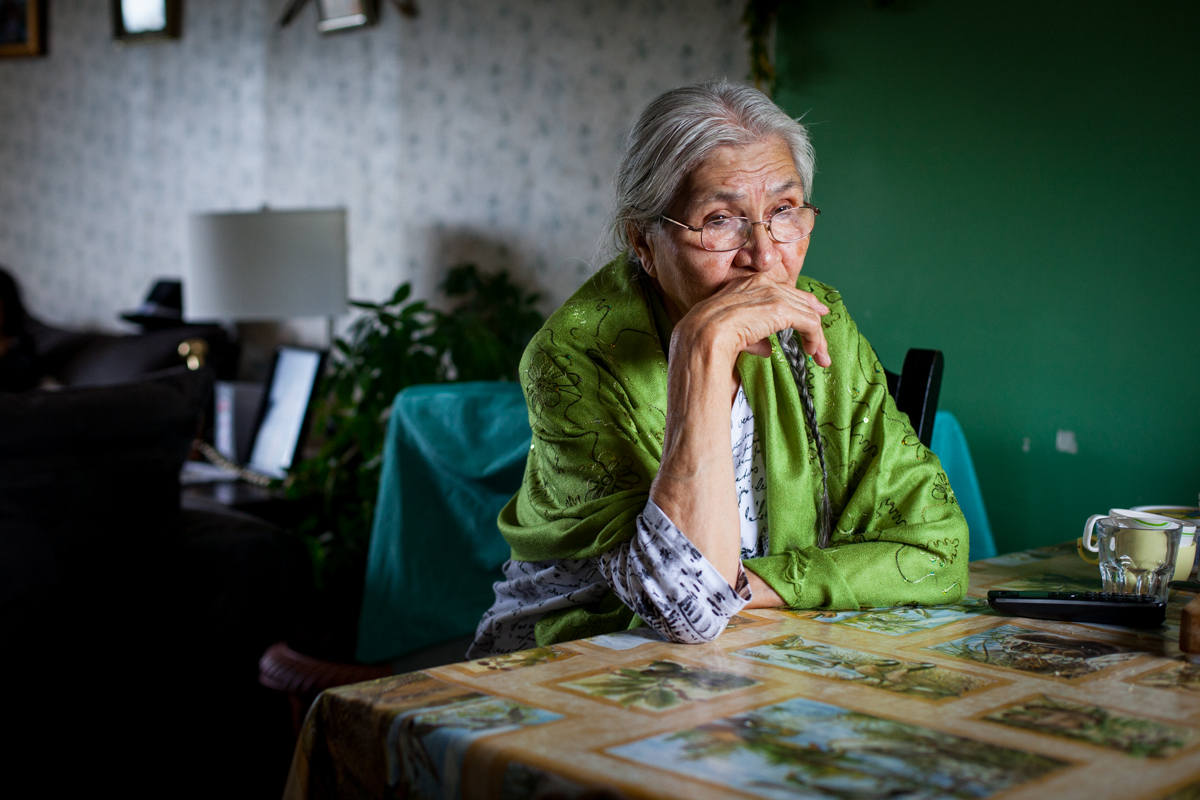
The late elder Madeline Spence of Nisichawayasihk Cree Nation (Nelson House) // Photo by Matthew Sawatzky, A Sad Sort of Clean
Do you find similarities between photography and landscape architecture?
I do. I find landscape architecture requires a lot of compositional skills when you’re laying out a space. The thought process that goes into it is similar to how you would set up and frame photographs in some regards. My background in photography has helped, in some ways, with how I approach some designs and how it would look in a picture if I designed it this way. That’s what I bring to that.
What do you do outside of school and photography?
Rock climbing is a hobby of mine right now. I’d say photography is a pretty big part of my life. If I’m not in school I’m working for a landscape architecture firm or landscaping or I’m on a Mennonite Central Committee (MCC) trip doing photography for them.
How did that come about?
Through my connections with my international development degree – a lot of my classmates from when I took that degree are now employed at MCC and I’ve been sending them my portfolio for years and it just so happens that the right people at the right time saw my stuff and gave me a shot and it’s been great ever since. I feel pretty lucky to do this kind of work. It’s very rewarding to travel and to see the every day life of people in these countries and not just the tourist side of things. To be a part of the work that MCC does is very inspiring to me as well.
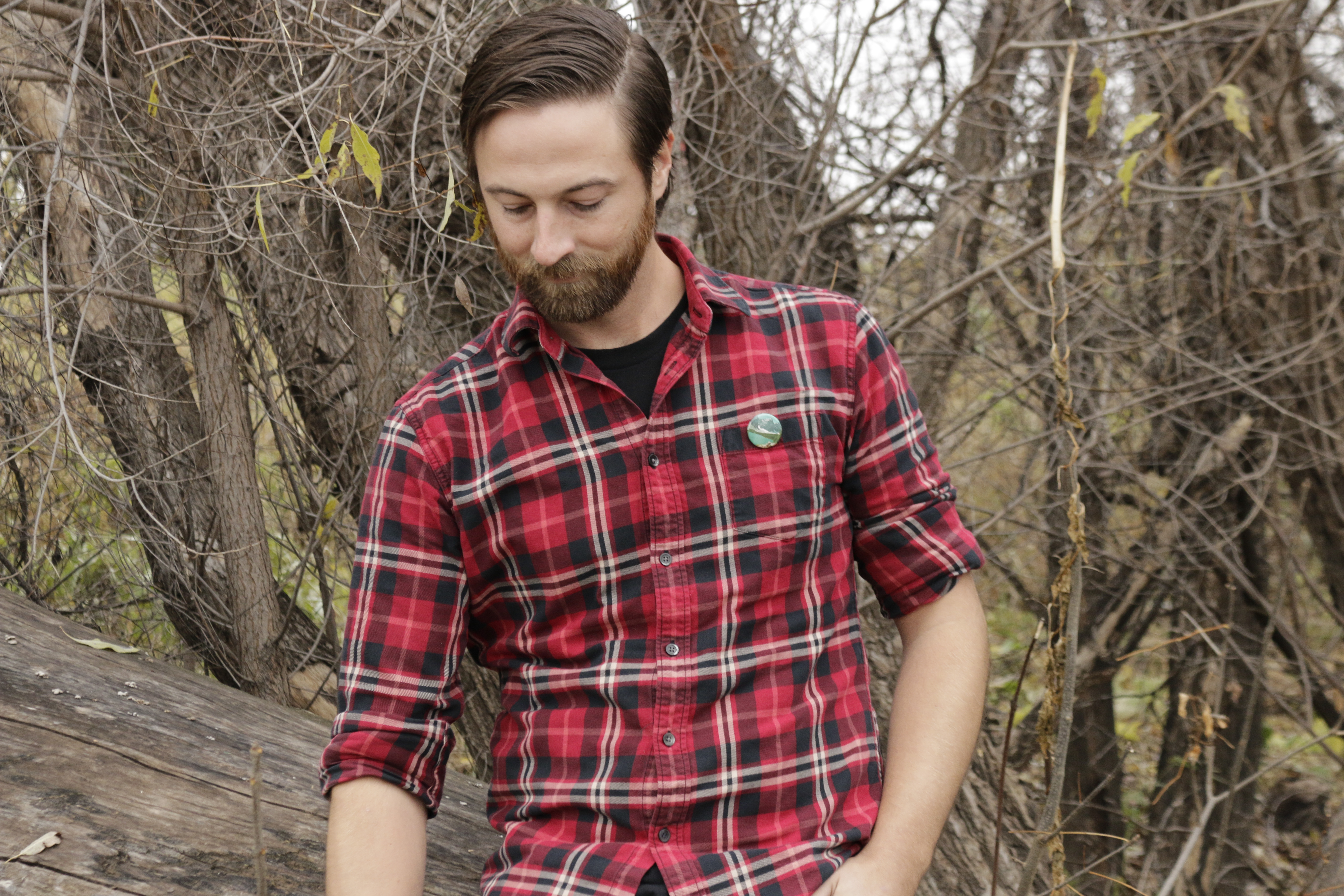
Do you carry a camera with you all the time?
The camera setup I have is pretty bulky so if I don’t need it I just keep my iPhone with me. That usually does for every day kind of stuff. If I have an assignment I have a pretty good gear setup that I’ll carry around.
What’s on your plate now?
In a week I’ll be leaving for Iraq and Jordan to do some freelance photography for MCC and it’ll focus more on internally displaced people and programs that MCC is running there. Following that I’ll be going to Nepal to do some follow up on the disaster relief regarding the earthquakes that happened earlier this year.
That’s pretty heavy.
Yeah. It’s scary and exciting but at the same time MCC has been working in the area for years and they’re very well versed in the safety protocols and who to talk to about what place is safe and where not to go. They have a lot of local staff that advises on that so I’m fairly confident that everything will go smoothly.
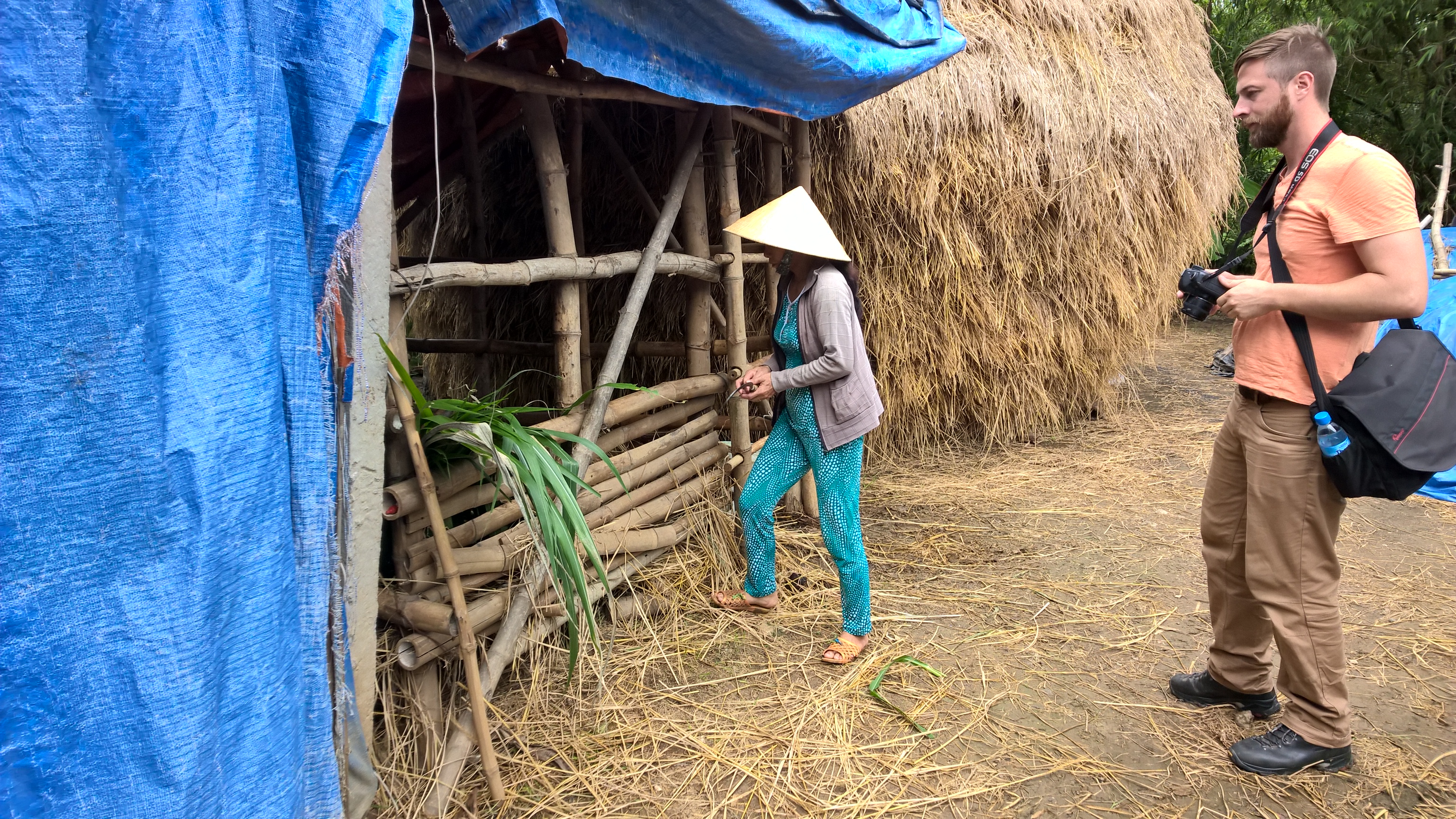
Matthew Sawatzky on assignment in Vietnam
What expectations do you have for these kind of trips?
I go with a little bit of knowledge about the projects we’re covering but it’s very kind of seat of the pants. Some people might not be available certain days so you just go a different direction so there are some opportunities for some really neat things to happen. I don’t go with a lot of expectations but you kind of hope that you get a really authentic meeting with somebody. Because they’re working with the projects that MCC helps with, they’re very welcoming with their personal life so you get to go into their home and talk to them in a very intimate way. You get this access that is uncommon if you were to just show up and knock on their door. They’re inviting you in and they’ll show you their farm or their house and the photos I’m able to get from that I feel are powerful and that is very rewarding to me. That’s what I hope for when I travel.
It sounds like you’re trying to tell a story with your photographs.
I want to use photography in a way that is not self-serving but is beneficial to the people I’m taking photos of. I’ve been inspired by National Geographic and other photojournalists and photo documentaries that show the humanity of people, that show the nobility of people – all kinds of people whether they’re in poverty or helping to relieve poverty, to show their spirit. You can see examples of really poorly done photography where they show people in their saddest state, people with flies in their eyes, really crying for the camera kind of thing. That’s just really degrading to the people but to everybody who’s part of that. It’s like a guilt trip system to try to extort money out of you. If you can form reputable stories in a hopeful way, it shows them for their whole character. Then you’ve done a good job I think. That’s what I hope that I’m able to do.
You’ve done a lot of travelling too.
I’ve been to Egypt, South Africa, Mozambique, Zambia, Zimbabwe, Nepal, India, New Zealand, Ukraine and Bosnia, and Guatemala.
All for photography?
Mostly for photography. In Egypt I volunteered with MCC – I was doing my practicum for my international development degree in Cairo for four months. That wasn’t photography-based but I did take a lot of pictures there.

What do you think your photos say?
I feel like my photos show a bit more life to stories we are kind of aware of already. It shows it on a personal level, how these individuals are impacted in a very direct way. Because I went with Ellen Cook, she’s a Cree elder, she did the interviews and translated. A lot of the interviews I didn’t understand at the time but I could see the emotion in people’s faces as they told their stories to her. When the stories were translated for me or when Ellen told me the story afterwards, it was very powerful to see how really affects people. The photos I hope, tell that personal, emotional impact that these stories hold.
What do you hope people are thinking when they look at these photos?
I hope they are able to learn, at least a little bit, what I learned on that trip. How deeply important the health of the land is to people in the photographs. For me that was a huge learning experience as well. I had general knowledge of the situation beforehand but a very shallow knowledge. When I visited these people and heard their stories, spending time with them, I learned a lot more how land and how deeply connected people are to the land and how little changes affect that relationship. When the land is sick then people feel it really deeply in their hearts. I know that’s a hard topic to portray in photographs but I tried that. I hope people get a sense of that.
What are you thinking when you’re shooting?
I guess it’s how you define spirituality. I’ll say this. My friend when he travels he purposefully does not take a camera because he wants to be in the moment and he feels like a camera will interfere with that. I feel like it’s the opposite for me. When I have a camera, I’m always trying to look and purposefully see, and look for a moment. So I feel like I’m even more hyper-aware.
Like you slow the moment down.
Yeah, like I slow the moment down. I’m more in the moment when I’m thinking about photography. I feel like it has its ties to spirituality in being in the moment.

What do your parents think of your photography?
They are very encouraging. My mom would prefer that I not travel so much but my dad is very encouraging and very understanding. I think I first became interested in photography because watching old family slides my dad took when he was younger.
How are you doing with that now?
I feel like it’s a work in progress. You can learn the technical side of photography fairly quickly and anyone can do that but I think there’s lifelong training and learning and recognizing moments and capturing and being ready for them. I’m still learning that. I’ve shot a number of weddings over the past couple of summers and that’s really good training for moment capturing because it’s a day full of moments and if you don’t get those moments then you’re not going to be a good wedding photographer.







Matthew did a 3 month photography stint with MCC Zambia several years back. We were the MCC program directors/country representatives at that time. His photos were published in quite a number of articles dealing with MCC’s work and program in Zambia. He certainly has a gift in seeing possible angles which enhance the mood and essence of the moment.